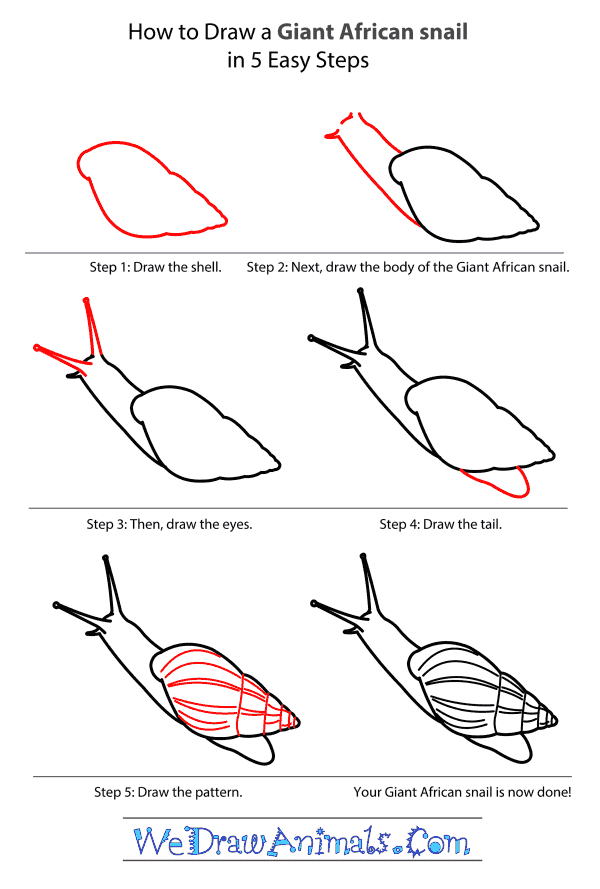In this quick tutorial you'll learn how to draw a Giant African Snail in 5 easy steps - great for kids and novice artists.
The images above represent how your finished drawing is going to look and the steps involved.
Below are the individual steps - you can click on each one for a High Resolution printable PDF version.
At the bottom you can read some interesting facts about the Giant African Snail.
Make sure you also check out any of the hundreds of drawing tutorials grouped by category.
How to Draw a Giant African Snail - Step-by-Step Tutorial
Step 1: Start the snail by drawing the shell. It kind of looks like a fat carrot on its side. The left side has round and curved lines. The left side comes to a gradual point.
Step 2: From the left top corner of the shell draw a short line on an angle up to the left. There is another line at the same angle starting at the bottom of the shell. Make a triangle at the very tip of the longer line.
Step 3: At the end of the top body line draw a long triangular eye. There is a small circle at the very tip. Make another long triangular eye the exact same size at the tip of the other body line.
Step 4: Under the bottom of the snail shell draw the tail. It looks like a sideways question mark
Step 5: Add the shell markings. There are many long lines that run the length of the shell. There are 5 short lines that go across the body.
Interesting Facts about the Giant African Snail (Achatina fulica):
The Giant African Snail can grow as large as a human hand, 20 centimeters or more in length, with a shell about 7 centimeters in height. The Great African Snail’s shell is cone-shaped, mostly brown in color, and has a banded color pattern, and spirals upwards. It is native to East Africa, but has been introduced worldwide via the pet trade and also by accident.
Did you know?
- The Giant African Snail is born with both male and female sex organs, making it what scientists call a “simultaneous hermaphrodite”.
- These snails can lay five to six clutches of eggs a year; each clutch contains up to two hundred eggs.
- In times of extreme drought, the African Giant Snail can seal itself up in its shell for up to three years; this way it does not lose any moisture from its body and can still survive.
- The African Giant Snail is an important food source in some areas, but should not be eaten raw as it can cause meningitis.
- This species of snail is mainly active at night; during the day it buries underground.
The Giant African Snail is one of the world’s most invasive species. It can out-compete native snails once introduced to an area. In addition, human and plant diseases can both be carried by the Giant African Snail, making it a serious pest. At this time, there are no known threats to this species.






